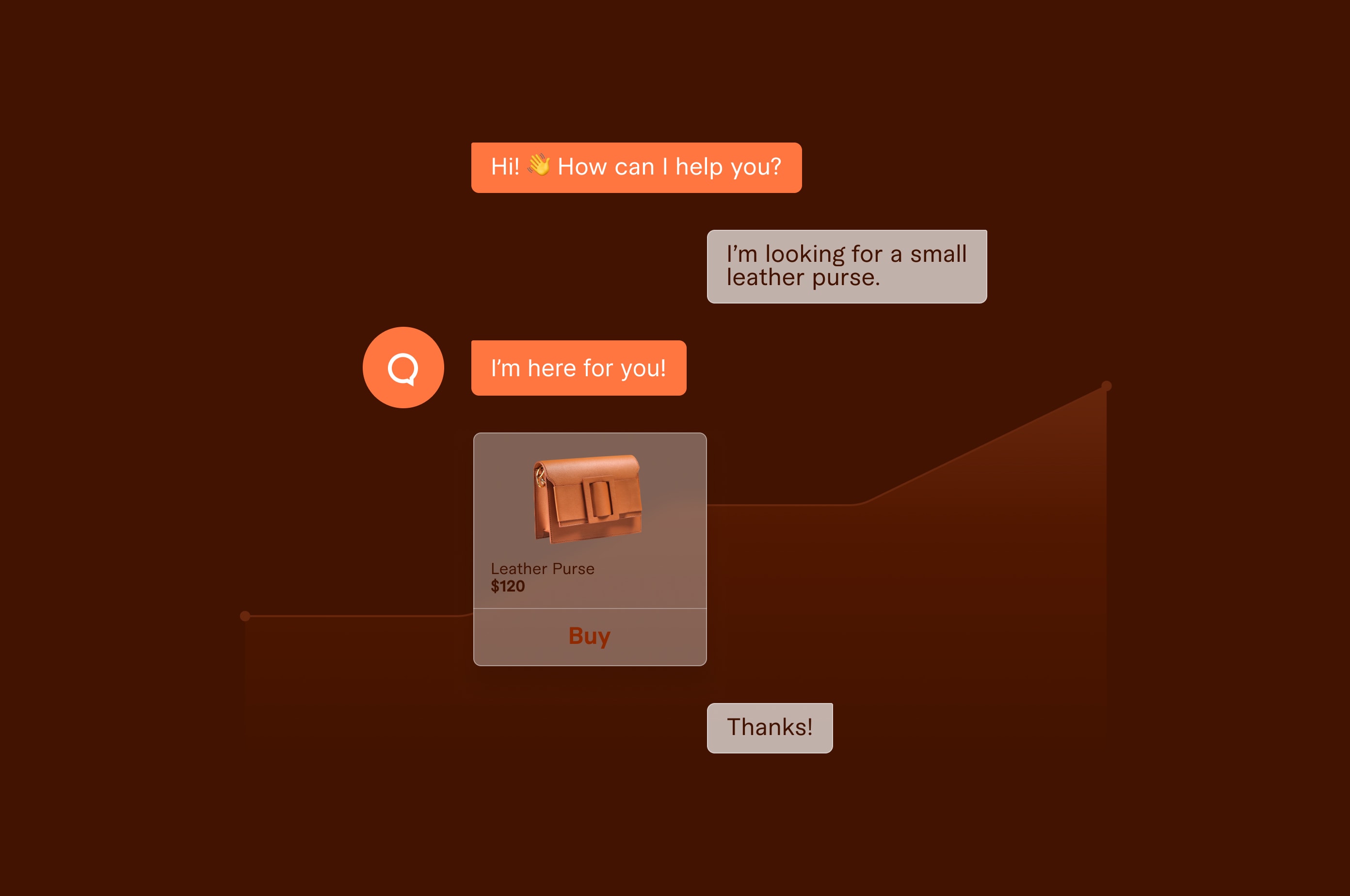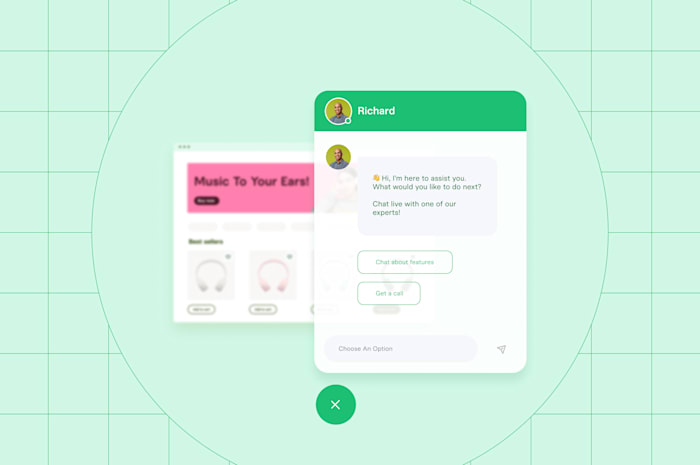Marketing Chatbots: What, Why, & How (+ Examples)
Learn how marketing chatbots can transform the digital user experience, drive digital marketing efficiency, and increase sales opportunities.
 February 29, 2024
February 29, 2024 9 minute reading
9 minute reading
“Hey, there!” 👋 “What can I help you with today?”
Ever bumped into such a friendly line from a chatbot in the right-hand corner of the screen?
It’s a straightforward example of how brands use marketing chatbots to engage their audience.
Likewise, there are potential customers on your site as we speak, and they’re bound to have queries about your product, service, or brand. If your marketing team isn’t powered to respond efficiently, it’s probably time to bring on the bots.
Scroll down to learn everything you need to know about marketing chatbots and get tips you can start using in your business right away.
Find an expert chatbot developer on Fiverr
What are marketing chatbots?
Marketing chatbots are rule-based computer programs that automate customer interactions and conversations on a website or in an app to generate sales.
Here’s an example of a marketing chatbot on Pantheon’s website:

Chatbots vs conversational AI: What's the difference?
Chatbots and conversational AI are often used interchangeably, but they’re distinct technologies.
Chatbots are pre-programmed and operate on a rigid “if-then” conversational logic.
Conversational AI uses artificial intelligence (AI), natural language processing (NLP), and machine learning (ML) to understand, process, and respond to real human communication in a natural and relevant way. AI chatbots mimic conversations better than their rule-based counterparts and generate relevant responses based on the user’s input.

You can use various chatbots in your marketing strategy to interact with prospects and customers.
Here are some of the most common types of chatbots and their duties:
Email automation bots: These bots can divide client lists based on demographics, behavior, past purchases, and other attributes. Plus, they can monitor and analyze click-through rates (CTRs), open email rates, and conversions; automate sending reminders and follow-up emails, and provide insights on your email campaign’s effectiveness.
Social media bots: You can manage and maintain your social media presence using bots that pre-schedule and post content, reply to customer queries, and monitor mentions and hashtags.
CRM bots: Your customer relationship management (CRM) process can be time-consuming and tedious to manage. Marketing chatbots take the repetitive, mundane tasks like sending customized emails, monitoring customer interactions, updating client profiles, suggesting next steps, and more.
Sales intelligence bots: These bots collect data on your prospects and customers to pick out high-intent leads, find trends and user preferences, and offer information on your competitors. Such bots can also recognize keywords and understand context, then direct customers toward relevant resources.
Now let’s talk about the benefits of marketing chatbots.
What are the benefits of using marketing chatbots?
Marketing chatbots can supercharge your entire marketing strategy. Here are some of the biggest benefits they bring.
Save time and resources
Marketing chatbots work for you 24/7, keeping your marketing engine going, and saving your customer support team time when they’re hard at work. Bots can handle repetitive and routine tasks, like starting conversations, sharing resources, and nudging qualified leads.
Engage and qualify leads
Marketing chatbots are also helpful with lead generation and customer engagement, handling tasks like:
Prompting prospects and customers with questions or resources to start conversations.
Asking questions to gather basic qualification details like company size, budget, and contact information for easier segmentation and personalization.
Qualifying high-intent leads by helping them book calls with your sales team and guiding them to conversion faster.
Offer personalized customer experiences
Based on the customer’s needs, marketing chatbots lead conversations and segment inbound traffic. This eliminates extra steps customers have to take to look for information, reduces friction in the customer journey, and serves up personalized experiences.
Nurture and upsell users
Marketing chatbots help visitors get set up and check in with users whose trial period is about to end. Bots share information on new features and pricing or connect them to human agents to help upgrade to paid plans.
Captures data for better decision-making
You can also use chatbots to collect data from website visitors and get valuable insights into their needs and wants. Then, use the data to inform your marketing strategy, product roadmap, and marketing campaigns.
Multichannel reach and scalability
You can integrate marketing chatbots into almost any platform. For instance, add them to social media channels, landing pages, SMS, or mobile and messaging apps to reach customers wherever they are.
Bots also scale as your customer base grows without you increasing staff or incurring more costs.
Before you run off and use marketing chatbots in your business, you’ll need a marketing chatbot strategy. Let’s go over exactly how to build one.
How to build a chatbot marketing strategy
Developing a plan for chatbot marketing shapes the overall user experience and the flow of conversations. The process involves defining your audience, how they interact with your brand, and how you’ll measure success.
Here’s a step-by-step guide to creating an effective chatbot marketing strategy.
1. Define goals and use cases
Clarify your marketing objectives and what you want to achieve with your chatbots to guide your strategy. Examples of goals include enhancing brand awareness, generating leads, or increasing conversions.
If your sales team struggles to find resources (videos, help articles, tutorials) for customers, you can use bots to quickly find and recommend them.
2. Identify your audience
Determine who your marketing chatbots will interact with. This requires understanding your audience demographics, pain points, preferences, and communication habits.
3. Pick a chatbot platform
After identifying your audience, you’ll need to pick a chatbot platform for your strategy.
Chatbot platforms like Slack, WhatsApp, or Facebook Messenger help you deploy your bots and guide you in determining what your bot should ask and the overall user experience.
4. Develop your chatbot marketing strategy
Figure out the content you want your audience to engage with throughout their interaction with the chatbots. You can start with frequently asked questions (FAQs), then build out chatbot conversation flows that guide users to the most ideal answers without involving human agents.
5. Create your marketing chatbots
Depending on your technical capabilities and budget, you can build your own chatbot using low-code or no-code chatbot technology or pre-built templates.
An easier and more preferred way is to use chatbot developers from platforms like Fiverr—a digital marketplace that connects you with talented professionals for all your project needs.
Give your marketing bots a personality to humanize the experience. Then, craft the bot’s voice to align them with your brand identity. Many brands give their bots names, like Axis Bank’s AHA bot.

Get a copywriter to review your site’s content, then set guidelines and a consistent voice for your chatbot.
6. Design conversational flows
Map out how users and bots will interact using these steps:
Create a conversational script and flow for your chatbots: Craft welcoming and compelling messages that move users in the desired direction based on customer questions. Use your knowledge base and other information resources can help you populate your chatbot with relevant, valuable content that can help resolve users’ concerns.
Define how the bots will interact with users: Determine how bots will set expectations, greet users and visitors, respond to common queries and customer feedback, and handle complex interactions.
Build out conversation trees: Map out the customer journey and create multiple responses for each question customers may want to ask. Some conversations may end after one question, others may span multiple levels. Let users know they’re chatting with a bot or virtual assistant and always offer an option to chat with a real person.
Add visual elements: Make your messages more compelling by including animated GIFs, images, videos, or emojis in your chatbot conversation. This brings more personality to your messages, reinforces your messages, and increases conversational marketing conversion rates.
Use call-to-action (CTA) buttons to guide users to checkout: Once a user responds to the questions and is ready to move forward, the chatbot interaction should culminate with a CTA based on the conversation. For instance, if you’ve implemented ecommerce chatbots, the CTA could lead directly to checkout or the user’s shopping cart.
7. Test, optimize, and go live
Test the chatbot journey to identify and address any bottlenecks or issues in each interaction. The best chatbot platforms will provide live preview functionality to test your conversation flows before going live.
Monitor how users interact with your marketing chatbots and note leaks that keep customers from moving forward.
8. Iterate and improve your strategy
Leverage user feedback and metrics to continuously optimize your bots’ responses. This ensures a smooth, seamless flow and user experience, and the information addresses users’ needs.
Use the data you gain to continuously improve your chatbot marketing strategy and adapt to your customers’ changing needs and trends.
3 examples of brands using marketing chatbots
Wondering how chatbots play into marketing? Here are a few examples of companies using marketing chatbots you can draw on for inspiration.
ConnectWise

ConnectWise uses marketing chatbots to direct customers to the content they need in as few steps as possible.
On the homepage, a bot offers visitors direct links to relevant resources based on their queries and an option to connect with the sales team. The bot answers questions for customers with faster response times, boosting customer satisfaction.
Mercedes Benz

Besides using ChatGPT as a voice assistant in its cars, Mercedes Benz uses a chatbot on its corporate website to elevate interactions with customers.
You can ask it any question, and the chatbot will respond in real time. For instance, I asked it about the latest models, and the bot responded with three different options based on my query.
Intercom

A leading AI customer service solution, Intercom also implements marketing chatbots on all key pages of its website, including the demo and pricing page.
Intercom’s bot pops up almost immediately, asking how it can help. Answer the questions, and the bot will ask multiple qualifying questions while offering suggestions and answers based on your input.
With marketing chatbots, Intercom can qualify leads 24/7 and instantly move them forward with minimal manual input.
Advance your marketing with chatbots
Your prospects and customers want to surface information and get responses quickly.
Implementing marketing chatbots to oversee this critical step eliminates potential communication frustrations, frees your team up to focus on higher-value tasks, and puts buyers back in control of their buying journey.
Ready to add marketing chatbots to your team?
Fiverr can connect you to qualified marketing strategists and chatbot specialists, so you get the most out of chatbot technologies. Plus, you’ll get a dashboard to manage your projects, freelancers, and finances at no monthly charge.
Sign up to Fiverr today to find, hire, and work with expert marketing chatbot strategy and development talent.



